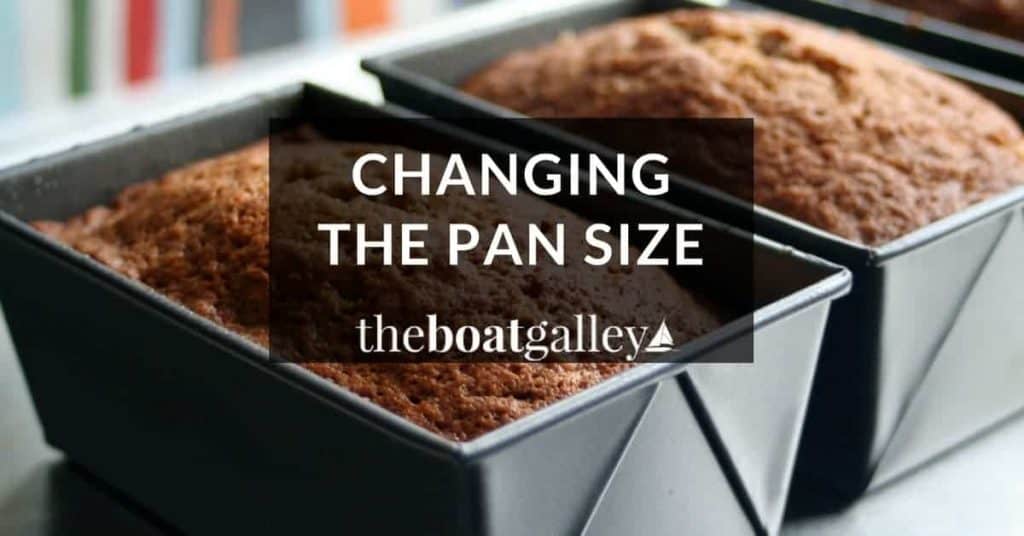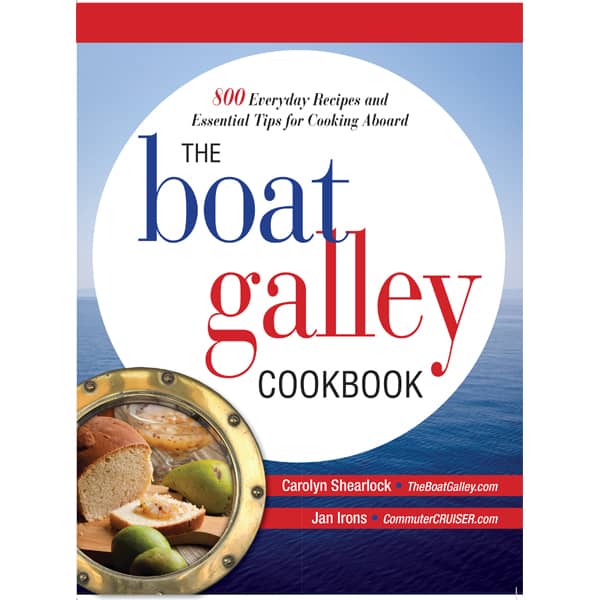How do you adjust the baking time if you use a different size pan or change the batch size? How long do you cook brownies if you use a 9×9 pan instead of an 8×8? And so on.
Many times, we don’t have the exact size pan called for in a recipe. While meat, casseroles and vegetables generally aren’t all that picky about the pan size, the situation is different with cakes, breads, desserts and other “baked goods.” Here’s how to successfully use a different size pan — and the key isn’t what a lot of other online sources say it is!
How to adjust the baking time and temperature for different size pans
For baking, the best pan substitutions are those where the batter is the same depth as was originally called for. In that case, you won’t have to change either the temperature or the time in the oven. The area of the bottom of the pan is the key to figuring this out.
- If you increase the area, the same amount of batter will be shallower. When the batter is shallower, the center will dry out faster than originally. Compensate by decreasing the baking time and raising the temperature so that the outside will still brown in the shorter time.
- If you decrease the area of the bottom of the pan, the batter will be deeper and the center will be underdone at the original time and temperature. To compensate, lower the temperature and increase the baking time.
How to know if you need to adjust the baking time
To know if you need to adjust the baking time and temperature, first figure out the area of the pan called for in the recipe. Then calculate the area of the pan you have. (The areas of common pan sizes are at the end of this article, as are the formulas for calculating the area of other pans). If the two numbers are within 10% of each other, you shouldn’t need to make any adjustment. Otherwise, adjust the time and temperature as described above — the exact amount of the changes will depend on how much the depth of the batter has changed.
Example
For example, if a recipe calls for baking in an 8×8 pan (64 square inch bottom) but you have a 9×5 loaf pan (45 square inches), the batter is going to be almost 1-1/2 times as deep. (To figure this, divide the original pan size in square inches by the new pan size = 64/45 = 1.4).
Since it will be deeper, you need to adjust the baking time and the temperature. Lower the temperature 25 degrees and begin testing for doneness according to the recipe directions at the original baking time plus ten percent (it probably will take about 25% more time, but I’d rather start checking too soon than too late).
Remember, the important thing is how deep the batter will be in the new pan compared to the old pan, not how deep the actual pans are in comparison to each other or what the total pan volume is. I have seen a number of pan size conversion charts online that talk about using a pan with the same total volume (it appears that they were all copied one from another since every word is identical) but the reality is that what’s important is the batter depth, not the total volume.
Special situation
If the depth of batter stays the same but the total amount in the pan changes dramatically — say, going from a 9×13 pan to making cupcakes — use the same temperature but start checking for doneness at half the original time (if going from bigger pan to smaller); if going from the smaller size to larger, it’s likely to take twice as much time, but you might want to start checking at the original time.
How to change the pan size if changing the batch size
The same concept applies if you halve a recipe or double it. For example, if you make half a recipe, you want a pan that has about half the area of the original pan – or you’ll have to compensate for the difference by adjusting the baking time and temperature.
Areas of common pan sizes
Here’s the area of some common pan sizes:
| Pan Size | Square Inches |
| 3” cupcakes or muffins | 7 |
| 6” round | 28 |
| 4” x 8” loaf | 32 |
| 5” x 9” loaf | 45 |
| 8” round | 50 |
| 9” round | 64 |
| 8” square | 64 |
| 7” x 11” | 77 |
| 9” square | 81 |
| 9” x 13” | 117 |
Formulas for calculating your own:
- Square or rectangular pan: Area = length x width
- Round pan: Area = (1/2 x diameter)2 x 3.14
If you have to calculate the area on a pan with sloping or curved sides – a pie pan is one example – measure the length, width or diameter halfway down.

Carolyn Shearlock has lived aboard full-time for 17 years, splitting her time between a Tayana 37 monohull and a Gemini 105 catamaran. She’s cruised over 14,000 miles, from Pacific Mexico and Central America to Florida and the Bahamas, gaining firsthand experience with the joys and challenges of life on the water.
Through The Boat Galley, Carolyn has helped thousands of people explore, prepare for, and enjoy life afloat. She shares her expertise as an instructor at Cruisers University, in leading boating publications, and through her bestselling book, The Boat Galley Cookbook. She is passionate about helping others embark on their liveaboard journey—making life on the water simpler, safer, and more enjoyable.
Simplify meal prep on board with proven strategies for provisioning, maximizing fridge space, and cooking delicious meals aboard your boat.










Candy Ann Williams on Facebook says
As usual another helpful article!!! Thanks
so much Carolyn…
mart says
thank you thank you thank you sooo much!
MaryJo Boyle says
Wow, excellent information!
terry L S. says
This is exactly what I was looking for…how handy…THANK YOU!!
rizwana sahraouei says
hi everyone im really stuck with this, i have two 14 by 12 by 2 inch rectangle pan but by how much do i increase the ingredients by if the original was two 8 inch round pans, really apprieciate if anyone could help. thank you all.
Carolyn Shearlock says
The bigger pans are a little more than three times as big as the round pans, so make a triple batch.
How I got this:
Area of the round pan: 8 divided by 2 gives the radius = 4. To get the area from that, it’s 4 x 4 3.14 (pi) = 50.24 square inches
Big pans: 14 x 12 = 168
168 divided by 50 = 3.36 — it’s a little more than 3 times as big so using three times the ingredients will work OK
Vee says
Very helpful. I’ve seen a lot of those other references (the ones that compare the total volumes of the pans) I’ve found myself quite confused by the “logic”. Good to see that it’s not just my general lack of baking experience speaking! Question: in your example, how did you get to 25 degrees (the amount by which temperature was to be decreased)? Is there some rule-of-thumb for judging temperature variances with respect to changes in batter depth? Or is 25 degrees a “safe” value to take off without affecting the baked result? Many thanks in advance!
Carolyn Shearlock says
The 25 degrees is just based on my experience and seems to usually work well. But some recipes and pan size changes may require a larger change, so yes, it’s a basic rule of thumb.
Ellen Bales says
My bread recipe calls for three 6x3x2″ mini-loaf pans, but I only have one. I do have an 8×4″ loaf pan that I want to use. How should I adjust the oven temp and baking time? Thanks so much!
Carolyn Shearlock says
Put 1/3 of the dough in the one 6×3 pan and bake that loaf for the stated time at the stated temp (that is, no adjustment).
Put the other 2/3 of the dough in the 8×4 pan and bake it at the same time at the same temp (no temp adjustment). Test it for doneness at the stated time — it may need to bake a little longer, say even 15 or 20 minutes, but I’d check it at the stated time. If it looks like it’s getting too brown, turn the temp down by 25 degrees for that last 15-20 minutes.
Good luck!
Rae says
I have a delicious Lemon blueberry loaf cake recipe that cooks for about 55min ,but my loaf is in use. I wanted to use my 8x8x2 square cake pan. How do I accommodate the time?
Carolyn Shearlock says
Raise the temperature by at least 25 degrees and start checking for doneness at half the original time, or at 25 minutes.
Diver dave says
I used 2 8×8. Instead of a 9×13 so I know I have 9 more cubic inches of pan with the same batter …. How much hotter should the over be then the 325 recommended ? It calls for 25 minutes so would 20 be the time to check it ?
Carolyn Shearlock says
That’s within 10% of the same square inches, so I’d use the same time and figure it would be close to the same time . . . maybe check it a little sooner.
Sam says
I am making a cream cheese banana nut bread …. sounds yummy huh ….. it calls for 2 loaf pans and I only have 1 so I was going to devide it up in an 8×8 and half in the loaf pan how should I adjust for this
Carolyn Shearlock says
The 8 x 8 pan is about twice the size of a loaf pan — most loaf pans are 8 x 4. So put it all in the 8 x 8 and bake it at the same temp and test it at the same time as the recipe calls for. It may take a little longer, but that’s a good start.
Connie Douglas says
I am baking my cake in a 7 inch square tin instead of a 8 inch round tin. For the round 8 inch it says to bake for 75 mins at 160 c. How long should I bake in square tin and what temperature? Please help!! 🙂
Carolyn Shearlock says
They have almost exactly the same number of square inches, so same time and temp.
8 inch round pan = 3.14 * (4^2) = 3.14 * 16 = 50.24 square inches
7 inch square pan = 7 * 7 = 49 square inches.
Stephanie says
I am baking a black and white cake that calls for an 8×8 pan. I only have a 10×14 (more than doubling the size that it calls for).
I plan on doubling the ingredients, but do I need to adjust the bake temp and time for doubling?
Thanks!
Carolyn Shearlock says
Since you’re doubling the ingredients and the pan size will be about 10% more than doubled — (8×8)x2 = 64×2 = 128 vs. 10×14 = 140 In general, when the sizes are within 10% of each other, you shouldn’t have to change the time or temp.
Laura says
My recipie calls for one batch to be made in a 9×5 but im going to double the batter using an 8×8 pan. I reversed the formula above, and got .703. Since it’s not within a 10% margin, am I to first increase the temp by 25 degrees and check it after about ten minutes of baking time? Thanks in advance!
Carolyn Shearlock says
The double batch would “need” a 9×10 pan (double the 9×5) to bake at the same time and temp. That’s 90 square inches. You’re using an 8×8, which is 64 square inches. It’s smaller, so the batter will be deeper.
LOWER the temp by 25 degrees and start checking it at the stated time, but it’s probably going to need 1-1/2 to double the original time.
David Marcussen says
brilliant!
Sharon Whitefoot says
If I am reading this correctly, to convert a muffin recipe to a loaf pan/quick bread, I would degrees the temp & increase the baking time.?
Pat Lanier says
I need to double a 9×13 for homemade Mac & cheese. Should I use a 15 ×12×3 or woukd an 18×12×2 be better.Does temp or time need to be adjusted. Thanks
Lisa Seaton says
I rarely post comments, but your information was so helpful-even to a land-lover!
Felisa A says
Thank you so much for this helpful information! I love that you post the mathematical info behind it…makes so much sense and helped me understand it better. And that way I can figure it out myself next time.
Nancy says
I am making a three layer cake that calls for batter to be placed in one 9×2″ round. All my 9″ rounds are too shallow so I am going to use my 8×3″ round instead. Can you advise me on this one? If I undertand correctly I should decrease temp by 25 and anticipate that it will take 1 1/2 times as long to bake but should start checking around time of original recipe.
Carolyn Shearlock says
Yep.
Ishara Nouman says
Hi i’m baking brownies which calls for a 8″ square pan but I have a 10″ square pan. Please tell me by how much should I increase the batter and the baking time and temperature.
Please advise
Great article 🙂
Carolyn Shearlock says
The whole purpose of this article is to teach you how to figure it out yourself!
Okay, an 8×8 pan has 64 square inches, while the 10×10 has 100. That’s about 50% more, so make 1-1/2 times the recipe and bake at the same temp for the same time.
Ishara Nouman says
Thank You so much. I figured it and made the brownies already and turned out great. 🙂 Thanks again
Nicole Cawood says
Hi. what a useful site, except I’m not good at conversions. I have a date loaf recipe which does not actually give a tin size of 15 x 20cm. I have a loaf pan 22 x 9 x 10. Will that be okay to use, and lengthen the baking time? Many thanks
Carolyn Shearlock says
Your batter will be a little thicker, so you might want to lower the temp a bit as well as bake it longer.
ramie streng says
Thanks very much. Now I think I know why all the neighbors made the same recipe for a plum cake, and they all turned out different!
Diane Persten says
I am making a corn casserole. The recipe calls for a 13×9, but I want to bake it in my counter top oven in a 9×9. The original temp is 350 for 45 minutes. How long do you think I should bake it for at 325?
Carolyn Shearlock says
Start checking at the original time . . . it’ll take longer, but you can get a feel for how long it’s likely to be from that. The other option is to make 2/3 of the recipe and bake it for the same time and temp.
Laning says
Thank you. You addressed my concern in trying to halve a recipe and now i can proceed with confidence
Chantal Nicole says
This is good info for anyone who just casually bakes, and doesn’t want a cupboard full of pans lol
Cynthia T says
My challenge is baking 1 box of premium brand mix brownies in an 11×7″ brownie pan, instead of the 8×8 pan the box mix insists on. I want thinner brownies for snacking, not thicker ones, so I don’t want to increase the recipe amount. I divided 64 sq. in. (8×8 pan) by the size of the new pan 77 sq in. (11×7). The batter will be .83 percent of the original depth, which is about 15% less. So, I plan to increase the baking temperature by 25 degrees, and cook the recipe 15-25% less time. Have I got this right?
Carolyn Shearlock says
Yep.
Lee Ford says
Thank you Cynthia T for posting the question,
and thank you Carolyn Shearlock for confirming the adjustments!
Chocolate/Browwnie/Cookie dilemma averted!
Lee F
Cynthia T says
Thanks for this terrific information, I’m a more versatile baker because of it!
Gratefully, Cynthia T
Arden says
i have a recipe for a brownie type bar that says to bake for 25 min in a 9 x 13, but is too
thick so would like to make it in a 1/2 sheet pan and cut it in larger, thinner pieces. How
long should I cook it and at what temp? Thanks for your help.